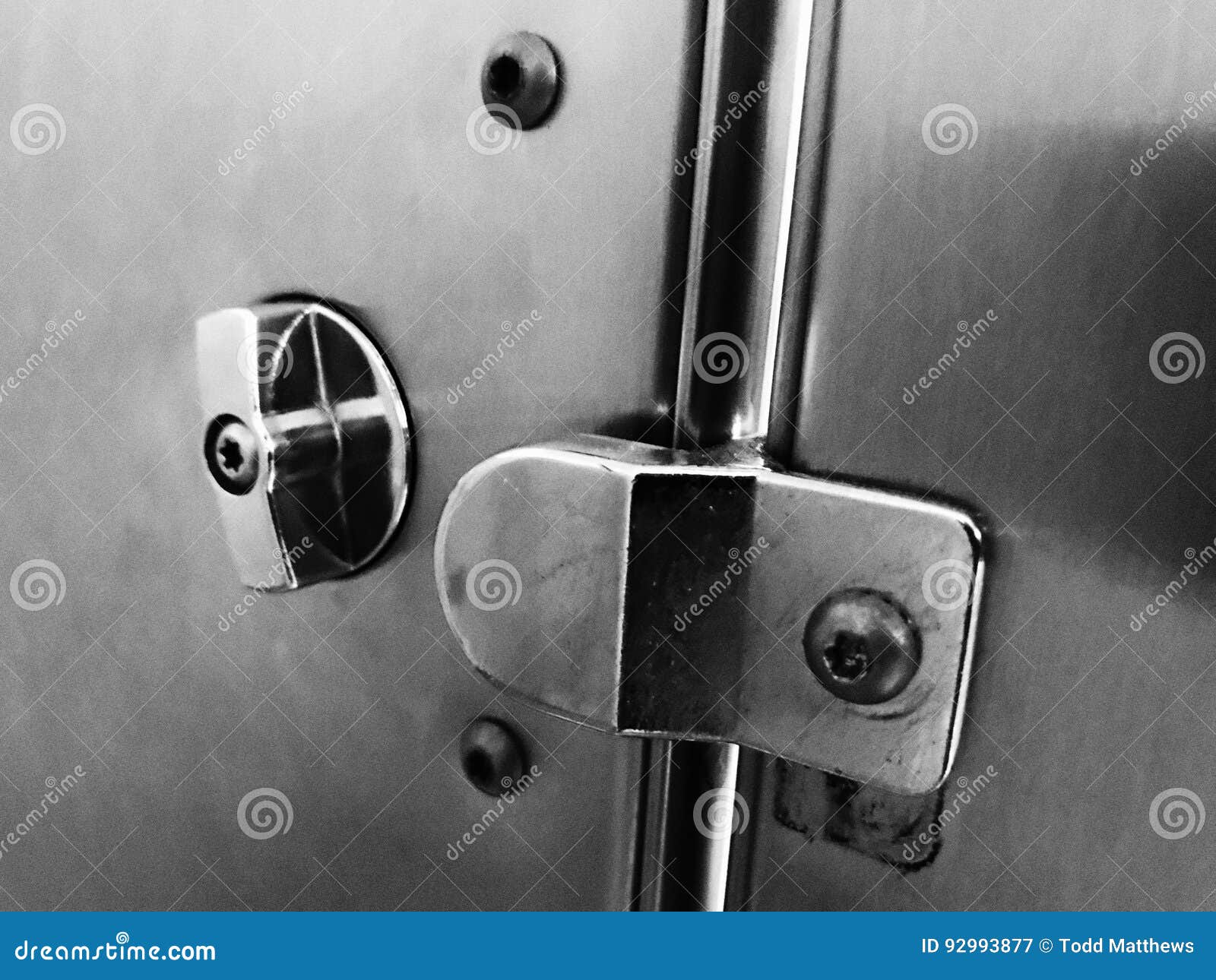Bathroom Stall Door Lock Types

Bathroom stall door locks are essential for providing privacy and security in restrooms. They come in various types, each with its unique features and benefits. Understanding the different types of locks available can help you choose the best option for your specific needs.
Latch Locks
Latch locks are the most common type of bathroom stall door lock. They are simple and straightforward to use, consisting of a latch that engages with a strike plate on the door frame. When the door is closed, the latch extends, locking the door. To unlock, the door handle is turned, retracting the latch.
- Pros: Latch locks are affordable, easy to install, and readily available. They are also reliable and provide basic security.
- Cons: Latch locks can be easily defeated with a simple tool, making them less secure than other types of locks. They also offer limited privacy, as the latch can be easily disengaged from the outside.
- Examples: Latch locks are commonly found in residential bathrooms, schools, and some office restrooms.
Push-Button Locks
Push-button locks are another common type of bathroom stall door lock. They feature a button that is pressed to engage the lock. To unlock, the button is pressed again.
- Pros: Push-button locks are relatively easy to use, particularly for children. They also offer a slightly higher level of security than latch locks, as the button needs to be pressed to disengage the lock.
- Cons: Push-button locks can be prone to jamming or malfunction, especially in high-traffic areas. They also provide limited privacy, as the lock can be easily disengaged from the outside by pressing the button.
- Examples: Push-button locks are often used in schools, public restrooms, and some office restrooms.
Privacy Locks, Bathroom stall door locks
Privacy locks are designed to provide a higher level of privacy than latch or push-button locks. They typically feature a deadbolt that engages with a strike plate on the door frame. To unlock, a key is required.
- Pros: Privacy locks offer the highest level of security and privacy. They are difficult to defeat without a key, providing peace of mind in sensitive environments.
- Cons: Privacy locks can be more expensive than other types of locks. They also require a key, which can be inconvenient if lost or misplaced.
- Examples: Privacy locks are often used in high-security restrooms, such as those found in hospitals, hotels, and upscale offices.
Electronic Locks
Electronic locks are the most advanced type of bathroom stall door lock. They utilize electronic mechanisms to engage and disengage the lock. They may feature keypads, card readers, or even biometric scanners for access control.
- Pros: Electronic locks offer the highest level of security and privacy. They can be programmed to restrict access to specific individuals or groups, and they are difficult to defeat without authorization.
- Cons: Electronic locks can be expensive to install and maintain. They also require a power source, which can be a concern in areas with frequent power outages.
- Examples: Electronic locks are commonly found in high-security areas, such as government buildings, airports, and corporate headquarters.
Functionality and Features

Bathroom stall door locks are essential for maintaining privacy and security in restrooms. They provide a barrier against unwanted intrusions and create a safe and comfortable environment for individuals using the facilities. Let’s delve into the functionality and features that make these locks crucial for modern restrooms.
Locking and Unlocking Mechanisms
Bathroom stall door locks typically employ a simple yet effective mechanism for locking and unlocking. They are often designed with a latch that engages with a strike plate when the door is closed. This latch can be operated by a handle or knob on the outside of the door, allowing individuals to lock the stall from within. The unlocking process is usually achieved by turning a key or pressing a button on the outside of the door, depending on the specific lock type. This basic mechanism ensures that the stall remains locked until intentionally unlocked.
Common Features of Bathroom Stall Door Locks
Bathroom stall door locks are equipped with a variety of features to enhance their functionality and security. These features include:
- Deadbolt Mechanisms: Deadbolt mechanisms provide an additional level of security by extending a solid metal bolt into the door frame when locked. This makes it more difficult for someone to force the door open, as the deadbolt resists attempts to pry or kick the door in.
- Panic Bars: Panic bars are designed for emergency situations. They are typically located on the inside of the door and can be easily activated by pushing a bar or lever. This mechanism allows individuals to quickly unlock the door from the inside, even if the regular lock is engaged. This feature is particularly important in restrooms, where safety and quick egress are paramount.
- Keyless Entry: Keyless entry systems use electronic mechanisms for locking and unlocking the door. They typically involve a keypad or card reader, allowing individuals to access the stall without using a physical key. These systems are convenient and can be easily managed, eliminating the need for keys and reducing the risk of lost or stolen keys.
- Anti-theft Features: Some bathroom stall door locks incorporate anti-theft features to deter theft and vandalism. These features may include tamper-resistant mechanisms, locking plates that are difficult to remove, or alarms that activate when the lock is tampered with. These measures contribute to the overall security of the restroom environment.
Importance of Features in Ensuring Security and Privacy
The features discussed above play a crucial role in ensuring security and privacy in restrooms. Deadbolt mechanisms enhance the strength and resistance of the lock, making it more difficult to force open. Panic bars provide a quick and reliable escape route in emergencies, prioritizing safety. Keyless entry systems offer convenience and improved security by eliminating the need for physical keys. Anti-theft features discourage theft and vandalism, protecting the restroom and its users from damage. By incorporating these features, bathroom stall door locks contribute to a safe, secure, and comfortable restroom experience.
Installation and Maintenance: Bathroom Stall Door Locks

Installing and maintaining bathroom stall door locks is a straightforward process, especially if you have some basic DIY skills. It involves understanding the different types of locks, the tools needed, and the steps involved. This section provides detailed guidance on installing and maintaining bathroom stall door locks to ensure their longevity and optimal performance.
Installing Bathroom Stall Door Locks
Installing a bathroom stall door lock requires some basic tools and understanding of the lock’s mechanism.
Tools and Materials
The following tools and materials are generally required for installing bathroom stall door locks:
- Phillips screwdriver
- Flathead screwdriver
- Drill
- Drill bits (appropriate size for the lock screws)
- Tape measure
- Level
- Pencil
- Safety glasses
- Work gloves
- Bathroom stall door lock (with necessary hardware)
Installation Steps
The installation process varies depending on the type of lock. Here’s a general guide:
- Prepare the Door: Ensure the door is closed and secured. Mark the location for the lock handle and latch using a pencil and level.
- Drill Pilot Holes: Drill pilot holes at the marked locations using a drill bit slightly smaller than the lock screws. This helps prevent splitting the wood.
- Install the Strike Plate: Attach the strike plate to the door frame using the provided screws. Ensure it’s level and aligned with the latch.
- Install the Lock Handle: Place the lock handle on the door and secure it using the provided screws. Make sure the handle is level and aligned with the strike plate.
- Install the Latch: Attach the latch to the door using the provided screws. Ensure it’s aligned with the strike plate.
- Test the Lock: Close the door and test the lock to ensure it functions smoothly and securely.
Maintaining Bathroom Stall Door Locks
Regular maintenance is crucial for ensuring the longevity and optimal performance of bathroom stall door locks.
Maintenance Tips
- Clean Regularly: Regularly clean the lock mechanism and handle with a soft cloth and mild soap to remove dirt and grime. Avoid using harsh chemicals that could damage the finish.
- Lubricate: Apply a small amount of lubricant, such as WD-40, to the lock mechanism to prevent rust and ensure smooth operation.
- Tighten Screws: Periodically check and tighten loose screws on the lock handle, latch, and strike plate to ensure secure attachment.
- Replace Worn Parts: Replace any worn or damaged parts, such as the latch or handle, to prevent malfunction and ensure proper locking function.
Bathroom stall door locks are a simple yet crucial safety feature, providing privacy and security. When designing a bathroom, it’s important to consider the overall aesthetic, and a great way to add a touch of tranquility is with a beautiful rug.
For a calming and sophisticated feel, consider a grey blue bathroom rug. It can complement the color scheme of the bathroom, while still providing a comfortable and welcoming space. And don’t forget the importance of reliable door locks for a truly relaxing and secure experience.
Bathroom stall door locks are essential for privacy and security, but sometimes they can be tricky to operate. If you’re looking for a more stylish and functional solution, consider a 24 inch barn door bathroom vanity with a built-in lock.
These vanities offer a modern look and can be easily customized to fit your bathroom’s style. Just remember to choose a lock that’s sturdy and easy to use, especially if you have children or elderly individuals in your home.